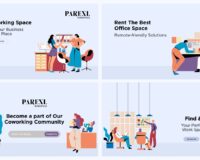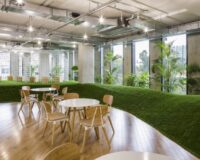The importance of choosing the right environment for business meetings
Meetings are critical to any organization in today’s swiftly evolving business landscape. Whether it involves deliberating essential strategies, reaching vital decisions, or engaging with fellow team members, meetings play a crucial role in driving the success of a business. Yet, what often eludes many is the profound influence the meeting setting can exert on overall productivity and efficacy. Opting for the appropriate location is vital to cultivating an ambiance that nurtures creativity, concentration, and collaboration.
Benefits of using a meeting room for business meetings
One of the primary benefits of using a meeting room for business meetings is the dedicated space it provides. Unlike cafes that are bustling with activity, meeting rooms offer a quiet and controlled environment where distractions are minimized. This lets attendees focus entirely on the meeting’s agenda, resulting in heightened productivity and improved decision-making. Additionally, meeting spaces have crucial amenities like audio-visual devices, whiteboards, and Wi-Fi, all essential for contemporary meetings. These provisions simplify idea sharing, information presentation, and efficient participant collaboration.
Another advantage of using a meeting room is the privacy it offers. Confidential or sensitive information in a cafe may be overheard by unintended individuals, posing a risk to the business. In contrast, meeting spaces provide a secure and private environment, ensuring that sensitive discussions are kept within the meeting’s boundaries. This confidentiality not only safeguards the interests of the business but also fosters trust among participants, encouraging open and sincere communication.
Drawbacks of using a cafe for business meetings
Although cafes might appear inviting and relaxed for meetings, they have some significant downsides. The foremost disadvantage is the absence of privacy. Cafes are public places, making it easy for conversations to be overheard by unintended ears. This jeopardizes the confidentiality of the meeting and increases the risk of exposing sensitive information. Moreover, the bustling noise and activity in cafes can be highly distracting, posing a challenge in sustaining concentration and having meaningful discussions. Background music, clattering utensils, and other patrons’ conversations can all contribute to a less productive meeting environment.
How the environment affects productivity in meetings
The setting where a meeting occurs can significantly influence the efficiency and effectiveness of the conversations. A thoughtfully designed meeting room offers a focused and organized ambiance, motivating participants to engage in the discussion fully. With minimal distractions, everyone can concentrate entirely on the tasks, resulting in more productive and effective meetings. In contrast, the bustling atmosphere of a cafe can disrupt concentration and hinder meaningful contributions.
Furthermore, a meeting room’s layout and visual appeal can impact the participants’ mood and drive. A well-lit, comfortable space with ergonomic furniture sets a positive tone that nurtures creativity and stimulates active involvement. In contrast, cafes may lack the necessary comfort and ergonomic support, leading to discomfort and fatigue during longer meetings. This can negatively impact the participants’ engagement and reduce their overall productivity.
Factors to consider when choosing a meeting room
- Consider various factors for an optimal meeting room setting, including location accessibility, minimizing travel time, and interruptions.
- Ensure the room size suits the number of participants, providing ample space for comfortable engagement.
- Prioritize essential amenities and technology: reliable Wi-Fi, audio-visual equipment, whiteboards, and comfortable seating arrangements.
- Equip the meeting room to support effective communication, collaboration, and visual presentations for efficient meeting objectives.
- Pay attention to the atmosphere within the room, considering ample natural light, good ventilation, and suitable acoustics to encourage productive discussions.
- Consider visual aspects like color schemes and decor, as they can subtly impact participants’ mood and creativity, contributing to a comfortable and captivating meeting space.
The advantages of a dedicated workspace for meetings
A dedicated workspace designed explicitly for meetings offers numerous advantages over alternative options such as cafes or open office spaces. Firstly, a meeting room provides privacy and confidentiality, ensuring that sensitive information remains secure. This can be crucial when discussing proprietary strategies, confidential client information, or important business decisions. The peace of mind that comes with a private meeting space allows participants to focus on the agenda without worrying about unintended eavesdropping.
Additionally, meeting rooms have the necessary technology and infrastructure to support modern-day meetings. These amenities facilitate seamless communication and collaboration, from audio-visual presentation equipment to conference call facilities for remote participants. This ensures that ideas are effectively shared, information is presented clearly, and decisions can be made efficiently.
Alternatives to meeting rooms – coworking spaces
While meeting rooms provide an ideal environment for business meetings, they may only sometimes be available or feasible for some organizations. In such cases, coworking spaces can serve as a suitable alternative. Coworking spaces offer a flexible and collaborative workspace where businesses and professionals from various industries work together. These spaces often provide dedicated meeting rooms that can be rented for specific durations, allowing organizations to access a professional meeting environment when needed.
Coworking spaces provide the benefits of a conventional meeting room, including privacy, essential facilities, and a professional atmosphere, all while fostering connections and collaboration with fellow professionals. This proves especially advantageous for startups or freelancers who might not have a fixed office location but still need a professional environment for client meetings or team interactions.
Comparison: meeting rooms vs cafes for business meetings
When comparing meeting rooms to cafes for business meetings, it becomes evident that meeting rooms offer several advantages that cafes simply cannot match. Meeting rooms provide a dedicated space that minimizes distractions, ensures privacy, and offers the necessary amenities for efficient meetings. The controlled environment and professional ambiance of meeting rooms contribute to increased productivity, effective communication, and better decision-making.
On the other hand, cafes lack the privacy and confidentiality required for sensitive business discussions. The noise and distractions in cafes can hinder concentration and limit effective communication. Diners also often need more technology and resources for productive meetings, making presenting ideas or collaborating effectively challenging.
Conclusion: Make the right choice for your business meetings
Choosing the right environment for business meetings is essential to ensure productivity, efficiency, and effective communication. While cafes may seem appealing for their relaxed atmosphere, meeting rooms provide the necessary privacy, amenities, and professional ambiance for successful meetings. The controlled environment and dedicated workspace of meeting rooms foster focus, creativity, and collaboration.
Ultimately, the decision between meeting rooms and cafes substantially influences the success of your business meetings. By prioritizing the environment and opting for a dedicated workspace, you can ensure that your appointments are productive, efficient, and aligned with your business objectives.




